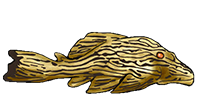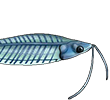Karine O. Bonato, Priscilla C. Silva and Luiz R. Malabarba. 2018. Unrevealing Parasitic Trophic Interactions—A Molecular Approach for Fluid-Feeding Fishes. Frontiers in Ecology and Evolution: pages 1-8. Published online March 15, 2018.
Abstract:
Fish diets have been traditionally studied through the direct visual identification of food items found in their stomachs. Stomach contents of Vandeliinae and Stegophilinae (family Trichomycteridae) parasite catfishes, however, cannot be identified by usual optical methods due to their mucophagic, lepidophagic, or hematophagic diets, in such a way that the trophic interactions and the dynamics of food webs in aquatic systems involving these catfishes are mostly unknown. The knowledge about trophic interactions, including difficult relation between parasites and hosts, are crucial to understand the whole working of food webs. In this way, molecular markers can be useful to determine the truly hosts of these catfishes, proving a preference in their feeding behavior for specific organisms and not a generalist. Sequences of cytochrome oxidase subunit 1 (COI) were successfully extracted and amplified from mucus or scales found in the stomach contents of two species of stegophilines, Homodiaetus anisitsi, and Pseudostegophilus maculatus, to identify the host species. The two species were found to be obligatory mucus-feeders and occasionally lepidophagic. Selection of host species is associated to host behavior, being constituted mainly by substrate-sifting benthivores. Characiformes are preferred hosts, but host choice depends on what characiform species are available in their environments, usually corresponding to the most abundant species. This is the first time that host species of parasitic fishes bearing mucophagous habits are identified, and demonstrates the effectiveness of the extraction and amplification of mitochondrial DNA from the ingested mucus in gut contents. The molecular markers effectively allowed determine parasite preferences and helps in better understanding the food web and trophic interaction on which fish species are involved. Despite, the methodology applied here can be used for an infinitive of organisms improving ecological trophic studies.
Open access at:
https://www.frontiersin.org/articles/10 ... 00022/full
On the diet of two mucus eating trichomycterid catfishes
-
lfinley58
- Expert
- Posts: 725
- Joined: 04 Jan 2003, 19:16
- I've donated: $90.00!
- My articles: 3
- My images: 3
- Spotted: 3
- Location 1: Margate
- Location 2: Florida USA
- Interests: Catfishes (all), Aquarium History
- bekateen
- Posts: 9650
- Joined: 09 Sep 2014, 17:50
- I've donated: $40.00!
- My articles: 4
- My images: 143
- My cats species list: 146 (i:106, k:34)
- My aquaria list: 37 (i:14)
- My BLogs: 44 (i:154, p:2563)
- My Wishlist: 36
- Spotted: 184
- Location 1: USA, California, Stockton
- Location 2: USA, California, Stockton
- Contact:
Re: On the diet of two mucus eating trichomycterid catfishes
Unrevealing...
Was that an intentional word choice or were the authors struggling to choose between Unveiling and Revealing?
I would have expected the editors to check that.
Cheers, Eric
Find me on YouTube & Facebook: http://youtube.com/user/Bekateen1; https://www.facebook.com/Bekateen
Buying caves from https://plecocaves.com? Plecocaves sponsor Bekateen's Fishroom. Use coupon code bekateen for 15% off your order. Also, for you Swifties: Https://youtu.be/ZUKdhXL3NCw
-
Bas Pels
- Posts: 2918
- Joined: 21 Dec 2006, 20:35
- My images: 1
- My cats species list: 28 (i:0, k:0)
- Spotted: 8
- Location 1: the Netherlands
- Location 2: Nijmegen the Netherlands
- Interests: Central American and Uruguayan fishes
Re: On the diet of two mucus eating trichomycterid catfishes
Frankly, while I did not find unrevealing in the summary, I can imagine why anyone would like to use this wordt.
Imagine a fish, large, but closely related to another. DNA analysis of scales found in the gut of a scaleeater could point to these species, but not be detailed enough to state which species the scales are coming from. After all, as stated, the fishes differ a lot in size, and therefore sensitivity to said scale-eater. Study of defferent genes could help - eventually
I could, in a conclusion, state that the used technique is, lamentably, unrevealing the species.
Imagine a fish, large, but closely related to another. DNA analysis of scales found in the gut of a scaleeater could point to these species, but not be detailed enough to state which species the scales are coming from. After all, as stated, the fishes differ a lot in size, and therefore sensitivity to said scale-eater. Study of defferent genes could help - eventually
I could, in a conclusion, state that the used technique is, lamentably, unrevealing the species.
cats have whiskers
-
lfinley58
- Expert
- Posts: 725
- Joined: 04 Jan 2003, 19:16
- I've donated: $90.00!
- My articles: 3
- My images: 3
- Spotted: 3
- Location 1: Margate
- Location 2: Florida USA
- Interests: Catfishes (all), Aquarium History
Re: On the diet of two mucus eating trichomycterid catfishes
Hi,
I agree totally regarding the word in question. It also left me thinking "Huh?"
The DNA was basically done on mucus in the GI tract. If you didn't already, check out the Supplementary Files for this. They seemed to come up with good matches by having done basic markers on fishes living along with the two catfishes of the topic. They might have well come up with some unknowns but overall provided some pretty good info on target species which was previously unknown.
There was a similar study done on a couple of ictalurid cats not long ago. They were basically getting a heavily digested fish mélange in the guts, but were able to match up this "pudding" with various prey species living in the same habitat.
Lee
I agree totally regarding the word in question. It also left me thinking "Huh?"
The DNA was basically done on mucus in the GI tract. If you didn't already, check out the Supplementary Files for this. They seemed to come up with good matches by having done basic markers on fishes living along with the two catfishes of the topic. They might have well come up with some unknowns but overall provided some pretty good info on target species which was previously unknown.
There was a similar study done on a couple of ictalurid cats not long ago. They were basically getting a heavily digested fish mélange in the guts, but were able to match up this "pudding" with various prey species living in the same habitat.
Lee




